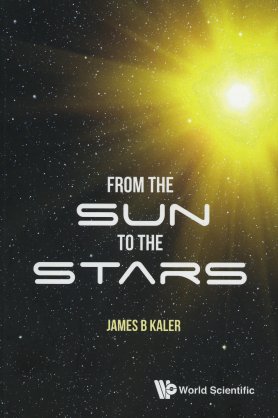
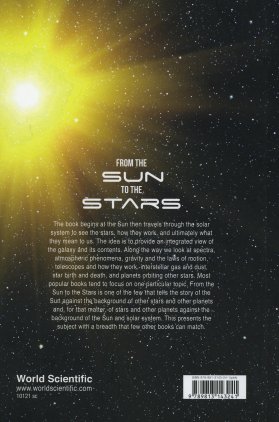

|

|
Publisher's Website |

|
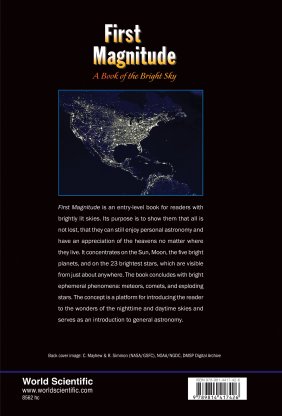
|
World Scientific, 2013. Read the interview with Jim Kaler. |
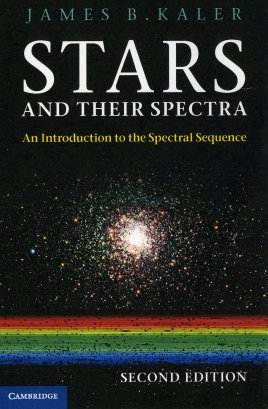
|
Cambridge University Press (UK or North Anerica), 2011. |
| The new "Stars and their Spectra," Second Edition, updates the classic 1989 original and the subsequent 1997 paperback version with new discoveries, two new chapters on ultracool stars, and 140 new illustrations. Chapter contents: 1. Stars; 2. Atoms and Spectra; 3. The Spectral Sequence; 4. The M stars: Red Supergiants to Dwarfs; 5. Descending the Staircase: Class L; 6. The Wet Basement: Class T; 7. The K stars: Orange Giants and Brighter Dwarfs; 8. Our Sun and its Cousins: the G stars; 9. Class F: Stars in Transition; 10. The White Stars of Class A; 11. The B Stars: Beacons of the Skies; 12. Class O: the Head of the Spectral Sequence; 13. Extraordinary Classes; 14. Journeys on the HR Diagram. |

|
Princeton University Press, Princeton, 2009. |
| Heaven's Touch, with 59 illustrations, entertainingly describes the multitude of intimate connections we have with the Universe, from tides through solar storms, asteroid/comet impacts, and cosmic rays, to exploding stars. Chapter contents: 1. Reaching Out; 2. Tides of Life; 3. Solar Storm; 4. Frozen Earth; 5. The Accidental Asteroid; 6. Crashing Comets; 7. Atomic Rain; 8. Super Star; 9. Hyperstars; 10. Coming Home. |
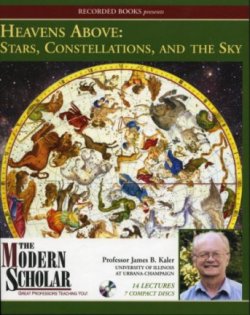
|
Recorded Books, Prince Frederick, MD, 2007. |
|
Heavens Above: Stars, Constellations, and the Sky (from
Recorded Books' "Modern Scholar" series) is a set of 14 lectures
on
audio CD that tells the wonderous tales of the stars, the patterns
that they form, the history of their names, of the continuous
changes in celestial apects, and at the heart of it, of the beauty
and intrigue of the heavens. The audio disks come with a 78-page
book illustrated in full color that summarizes the lectures.
Lecture/Chapter contents: 1. Sky and Stars; 2. Constellations; 3.
Circles of Earth; 4. Celestial Circles; 5. Rising and Setting; 6.
That Old Sun; 7. Star Names; 8. The Sacred Zodiac; 9. Wobbles; 10.
Astronomy, Astrology, and UFOs; 11. Mythical Magic; 12. Singular
Sights; 13. Modern Design; 14. The Milky Way. |

|
Cambridge University Press, Cambridge, 2006. |
| The Cambridge Encylopedia of Stars, with over 200 illustrations, is a unique book that provides a comprehensive description of stars and their natures. Detailed cross referencing enables the reader to explore topics in depth, making an invaluable work both for beginners and for those with a more advanced interest in stars and stellar evolution. Chapter contents: 1. Stars and Constellations; 2. Location; 3. Magnitudes; 4. Distances; 5. The Galaxy in Motion; 6. Spectra and the HR Diagram; 7. Stellar Properties; 8. Double and Multiple Stars; 9. Star Clusters and Associations; 10. Variable Stars; 11. Star Formation; 12. Sun and Main Sequence; 13. Stellar Evolution; 14. High Mass Evolution. |
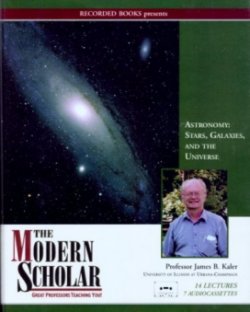
|
Recorded Books, Prince Frederick, MD, 2004. |
|
Astronomy: Stars, Galaxies, and the Universe (from Recorded
Books' "Modern Scholar" series), winner of Audiofile
magazine's Earphones Award, is an accessible astronomy
course given as a set of 14 lectures on audio CD that describes
the
exciting tale of space and time beyond the Solar System, in which
we begin with the Sun and launch ourselves into the depths of the
Universe. The audio disks come with a complete 100-page book in
full color that summarizes the lectures.
Lecture/Chapter contents: 1. The Neighborhood; 2. The Central Sun;
3. The Making of Sunlight; 4. Billions of Stars; 5. Ganging Up; 6.
Between the Stars; 7. Star Birth; 8. Stellar Fate; 9. Catastrophe;
10. Neutron Stars and Black Holes; 11. The Galaxy; 12. Galaxies;
13. The Expanding Universe; 14. Cosmic Origins in the Big Bang.
|
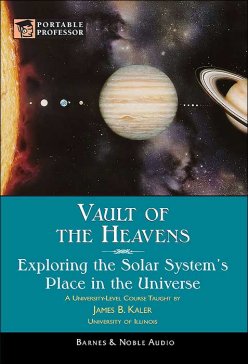
|
Barnes and Noble, New York, 2004. |
|
Vault of the Heavens: Exploring the Solar system's Place in the
Universe (part of Barnes and Noble's "Portable Professor
Series") is an accessible astronomy course given as a set of 14
lectures on audio CD that describes the exciting tale of the Solar
System. The audio disks come with a complete 100-page book in
full
color that summarizes the lectures. Lecture/Chapter contents: 1.
We and the Universe; 2. Reflections of the Spinning Earth; 3. Sun
and Seasons; 4. Stories in the Sky: Constellations; 5. Romance of
the Moon; 6. Happy Wanderers: The Planets; 7. Keeping It All
Together; 8. Reaching Outward; 9. Our Domain: Earth and Moon; 10.
Iron Planets: Mercury, Venus, and Mars; 11. Monsters of the
Midway:
Jupiter and Saturn; 12. Distant Outposts: Uranus, Neptune, and
Pluto; 13. Leftovers of Creation: Comets, Asteroids, and Meteors;
14. Creation. Vault of the Heavens is also published as Astronomy: Earth, Sky, and Planets by Recorded Books as part of The Modern Scholar series. |
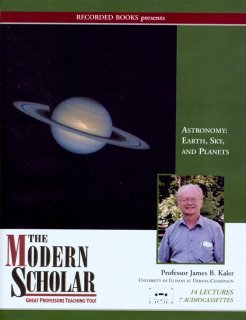
|
Recorded Books, Prince Frederick, MD, 2003. |
|
Astronomy: Earth, Sky, and Planets (from Recorded Books'
"Modern Scholar" series) is an accessible astronomy course
given as a set of 14 lectures on audio CD that describes the
exciting tale of the Solar System. The audio disks come with a
complete 100-page book in full color that summarizes the lectures.
Lecture/Chapter contents: 1. We and the Universe; 2. Reflections
of
the Spinning Earth; 3. Sun and Seasons; 4. Stories in the Sky:
Constellations; 5. Romance of the Moon; 6. Happy Wanderers: The
Planets; 7. Keeping It All Together; 8. Reaching Outward; 9. Our
Domain: Earth and Moon; 10. Iron Planets: Mercury, Venus, and
Mars;
11. Monsters of the Midway: Jupiter and Saturn; 12. Distant
Outposts: Uranus, Neptune, and Pluto; 13. Leftovers of Creation:
Comets, Asteroids, and Meteors; 14. Creation. Astronomy: Earth Sky, and Planets" is also published as Vault of the Heavens: Exploring the Solar system's Place in the Universe by Barnes and Noble as part of the Portable Professor Series. |
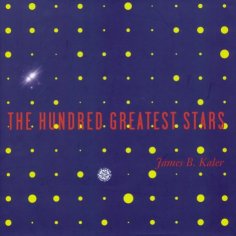
|
Copernicus Books, New York, 2002. Translated into Dutch. |
| From Acrux to ZZ Ceti, The Hundred Greatest Stars tells the stories of a selection of the most fascinating stars the sky has to offer. Each is given a quick summary that is accompanied by a one- page description and a full-page illustration. A short introduction to stars is followed by the Hundred without the use of chapters. The 100 star-stories are in turn followed by listings by standard and alternative names, by order of evolution, and by position on the sky. |

|
Cambridge University Press, Cambridge, 2001. |
| Extreme Stars: At the Edge of Creation, the American Association of Publishers Outstanding and Scholarly Title in Physics and Astronomy for 2001, is a unique book that describes the lives of stars from a new perspective. It examines their amazing extremes, and results in as refreshing, up-to-date and engaging overview of stellar evolution. Chapter contents: 1. The Sun and Stars; 2. The Faintest (and Coolest) Stars; 3. The Coolest Stars...Continued; 4. The Hottest Stars; 5. The Brightest Stars; 6. The Largest Stars; 7. The Smallest Stars; 8. The Youngest Stars; 9. The Oldest Stars; 10. The Strangest Stars. |
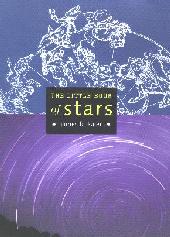
|
Copernicus Books, New York, 2001. Translated into Italian and Greek. |
| The Little Book of Stars is an introductory book on stars that shows how modern astronomers have come to understand our stellar companions, the book describing their hidden births and violent deaths, their immense ages, and the near-unbelievable variety of sizes and configurations in which they exist. Chapter contents: 1. Stars; 2. Collections; 3. The Family; 4. Nightly Parade; 5. Stellar Surprise; 6. Linkages; 7. Dawn. |

|
Scientific American Library, Freeman, New York, 1997. Translated into Dutch and German. |
| Cosmic Clouds takes the reader on a journey through the spaces between the stars, through the vast clouds of dust and gas that constitute the interstellar medium, to explore the grand Galactic cycle of birth and death. Chapter contents: 1. Among the Stars; 2. Entering the Nebulae; 3. Dark Dust; 4. Opening the Spectrum; 5. Molecules!; 6. Star Formation; 7. Distilling the Planets; 8. Planets to Planetaries to Planets; 9. Paths to Glory and Creation; 10. Cosmic Cycles. |
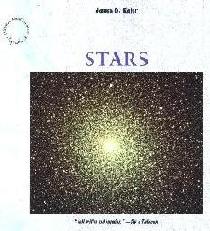
|
Scientific American Library, Freeman, New York, paperback edition of Stars with updates and corrections, 1998. |
| Stars are the primary converters of matter into energy in the Universe, the ultimate sources and sustainers of life. The book explores the natures of stars, describing our current knowledge of their origin, variety. distribution, composition, and distinctive histories. Here we see that the development, death, and birth of stars is intimately associated with our own origins and continued existence. Chapter contents: 1. From Ancient Wonder; 2. The Tools of Discovery; 3. The Discovery of Reality; 4. To Build a Star; 5. Coming of Age; 6. Catastrophe; 7. First Light of Day. |

|
Scientific American Library, Freeman, New York, 1992. Translated into Dutch, French, German, Italian, and Japanese. |
| Stars are the primary converters of matter into energy in the Universe, the ultimate sources and sustainers of life. The book explores the natures of stars, describing our current knowledge of their origin, variety. distribution, composition, and distinctive histories. Here we see that the development, death, and birth of stars is intimately associated with our own origins and continued existence. Chapter contents: 1. From Ancient Wonder; 2. The Tools of Discovery; 3. The Discovery of Reality; 4. To Build a Star; 5. Coming of Age; 6. Catastrophe; 7. First Light of Day. |

|
Paperback edition, Cambridge University Press, Cambridge, 2002. |
| The Ever-Changing Sky provides a comprehensive and uniquely non-mathematical guide to spherical astronomy, in which the reader is led through terrestrial and celestial coordinate systems, time measurement, and celestial navigation. The book progresses through general discussions of constellations, planetary and lunar orbits, tides, eclipses, and atmospheric phenomena. Chapter contents: 1. The Earth and the Celestial Sphere; 2. The Moving Earth and the Traveling Observer; 3. The Orbital Motion of the Earth; 4. Stars and Constellations; 5. Precession, Nutation, and Aberration; 6. Time; 7. Sunrise and Sunset; 8. Positions in the Sky and on Earth; 9. The Moon; 10. Tides, Eclipses, and Calendars; 11. The Planets; 12. The Small Bodies of the Solar System; 13. Light and the Atmosphere. |

|
Cambridge University Press, Cambridge, 1996. |
| The Ever-Changing Sky provides a comprehensive and uniquely non-mathematical guide to spherical astronomy, in which the reader is led through terrestrial and celestial coordinate systems, time measurement, and celestial navigation. The book progresses through general discussions of constellations, planetary and lunar orbits, tides, eclipses, and atmospheric phenomena. Chapter contents: 1. The Earth and the Celestial Sphere; 2. The Moving Earth and the Traveling Observer; 3. The Orbital Motion of the Earth; 4. Stars and Constellations; 5. Precession, Nutation, and Aberration; 6. Time; 7. Sunrise and Sunset; 8. Positions in the Sky and on Earth; 9. The Moon; 10. Tides, Eclipses, and Calendars; 11. The Planets; 12. The Small Bodies of the Solar System; 13. Light and the Atmosphere. |

|
Cambridge University Press, paperback edition with updates and corrections, Cambridge, 1997 |
| The study of stars and their spectra is central to an understanding of classical and modern astronomy. The book clearly explains the alphabet of stellar astronomy and tells the story of the evolution of stars and their place in the Universe. Chapter contents: 1. Stars; 2. Atoms and Spectra; 3. The Spectral Sequence; 4. The M stars: Red Supergiants to Dwarfs; 5. The K stars: Orange Giants and Brighter Dwarfs; 6. Our Sun and its Cousins: the G stars; 7. Class F: Stars in Transition; 8. The White Stars of Class A; 9. The B Stars: Beacons of the Skies; 10. Class O: the Head of the Spectral Sequence; 11. Extraordinary Classes; 12. Journeys on the HR Diagram. |
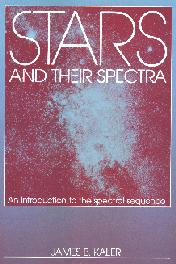
|
Cambridge University Press, Cambridge, 1989. Translated into German. |
| The study of stars and their spectra is central to an understanding of classical and modern astronomy. The book clearly explains the alphabet of stellar astronomy and tells the story of the evolution of stars and their place in the Universe. Chapter contents: 1. Stars; 2. Atoms and Spectra; 3. The Spectral Sequence; 4. The M stars: Red Supergiants to Dwarfs; 5. The K stars: Orange Giants and Brighter Dwarfs; 6. Our Sun and its Cousins: the G stars; 7. Class F: Stars in Transition; 8. The White Stars of Class A; 9. The B Stars: Beacons of the Skies; 10. Class O: the Head of the Spectral Sequence; 11. Extraordinary Classes; 12. Journeys on the HR Diagram. |
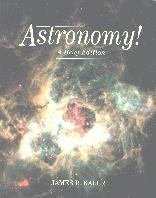
|
Addison Wesley Longman, Menlo Park, 1997. |
| Astronomy: A Brief Edition, an introductory textbook, is a shortened, revised edition of the author's Astronomy!. Chapter contents: 1. From Earth to Universe; 2. Earth, Sun, and Sky; 3. The Face of the Sky; 4. Earth, Moon, and Planets; 5. Gravity; 6. Atoms, Light, and Telescopes; 7. Home: the Double World; 8. Rocky Worlds; 9. Great Worlds; 10. Outer Worlds; 11. Creation and its Debris; 12. The Sun; 13. The Stars; 14. Star Formation; 15. The Life and Death of Stars; 16. The Galaxy; 17. Galaxies; 18. The Expansion and Structure of the Universe; 19. The Universe. |
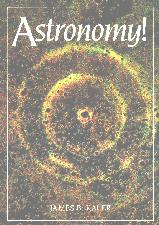
|
HarperCollins, New York, 1994. Now published by Addison Wesley Longman , Menlo Park. |
| Astronomy!: a full-sized introductory textbook. Chapter contents: 1. From Earth to Universe; 2. The Earth and the Sky; 3. The Earth and the Sun; 4. The Face of the Sky; 5. The Earth and the Moon; 6. The Planets; 7. Newton, Einstein, and Gravity; 8. Atoms and Light; 9. The Tools of Astronomy; 10. The Earth; 11. The Moon; 12. Hot Worlds; 13. Intriguing Mars; 14. Magnificent Jupiter; 15. Beautiful Saturn; 16. Outer Worlds; 17. Planetary Creation and its Debris; 18. The Sun; 19. The Stars; 20. Stellar Groupings: Doubles, Multiples, and Clusters; 21. Unstable Stars; 22. The Interstellar Medium; 23. Star Formation; 24. The Life and Death of Stars; 25. Catastrophic Evolution; 26. The Galaxy; 27. Galaxies; 28. The Expansion and Construction of the Universe; 29. Active Galaxies and Quasars; 30. The Universe. |

|
Jensan Scientifics |
| Elements of the Universe is an educational kit that takes the chemical elements from their birthplaces in the nuclear cauldrons of the stars and brings them home to show how each is incorporated in various minerals and how it is used in the practical world. The kit comes with samples of minerals that illustrate the periodic table and a detailed explanatory teacher's guide. Chapter contents: 1. Table of Contents (index to the periodic table); 2. Table of Minerals; 3. Introduction- Astronomical; 4. Introduction-Mineralogical; 5. The Elements; 6. Student Handouts; 7. Teacher's Answer Key; 8. Guide to Scientific Terms; 9. Bibliography; 10. Suggested Reading. |
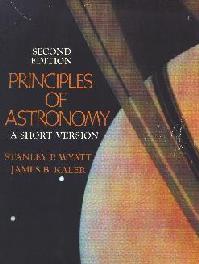
|
Allyn and Bacon, Inc., Boston, second edition 1981, first edition 1974. |
| Principles of Astronomy: A Brief Edition is a shortened, revised version of S. P. Wyatt's textbook Principles of Astronomy, Allyn and Bacon, second edition, 1971. Chapter contents: 1. Prospect; 2. Planet Earth; 3. Earth, Sky, and Time; 4. Atoms, Radiation, and Telescopes; 5. Our Moon; 6. Planetary Motion; 7. The Principal Planets; 8. Asteroids, Comets, and Meteoroids; 9. The Solar system: Origin and Evolution; 10. The Sun; 11. The Stars: Observable Properties; 12. Multiple Stars, Clusters, and Associations; 13. The Stars: Intrinsic Properties; 14. The Variable Stars; 15. Matter Between the Stars; 16. The Stars: Evolution; 17. The Home Galaxy; 18. Galaxies; 19. The Universe of Galaxies; 20. Retrospect. |

|
First published by Princeton University Press, Princeton, 2009. |
Simplified Chinese translation of Heaven's Touch, published by Shanghai Educational Publishing House, 2015. |

|
First published by Copernicus Books, NY, 2001. |
Greek translation of The Little Book of Stars, published by Alexandria Publications, 2006. |

|
First published by Copernicus Books, NY, 2002. |
Dutch translation of The Hundred Greatest Stars, published by Veen Magazines, Diemen, 2005. |

|
First published by Copernicus Books, NY, 2001. |
Italian translation of The Little Book of Stars, published by l'Astronomia, Milano, 2001. |

|
First published by Scientific American Library, Freeman, New York, 1997. |
Dutch translation of Cosmic Clouds, published by Natuur and Techniek, Maastricht/Brussel, 1998. |
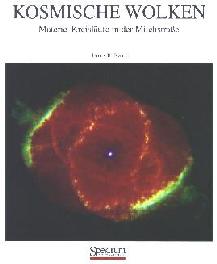
|
First published by Scientific American Library, Freeman, New York, 1997. |
German translation of Cosmic Clouds, published by Spektrum Akademsischer Verlag, Heidelberg/Berlin, 1998. |
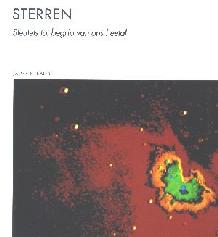
|
First published by Scientific American Library, Freeman, New York, 1992. |
Dutch translation of Stars published by Natuur and Techniek, Maastricht/Brussel, 1994. |
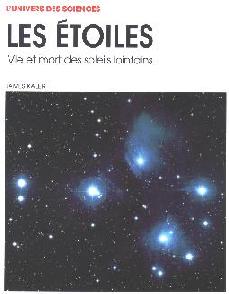
|
First published by Scientific American Library, Freeman, New York, 1992. |
French translation of Stars published by Pour la Science, Paris, 1997. |
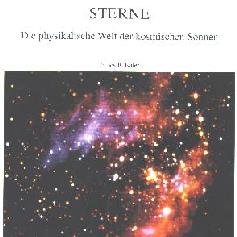
|
First published by Scientific American Library, Freeman, New York, 1992. |
German translation of Stars published by Spektrum Akademischer Verlag GmbH, Heidelberg/Berlin/Oxford, 1993. |

|
First published by Scientific American Library, Freeman, New York, 1992. |
Italian translation of Stars by Zanichelli Editore, Bologna, 1995. |

|
First published by Scientific American Library, Freeman, New York, 1992. |
Japanese translation of Stars arranged by Tuttle-Mori Agency. |
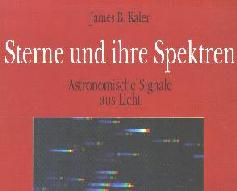
|
First published by Cambridge University Press, Cambridge, 1989. |
German translation of Stars and their Spectra, published by Spektrum Akademischer Verlag GmbH, Heidelberg/Berlin/Oxford, 1994. |